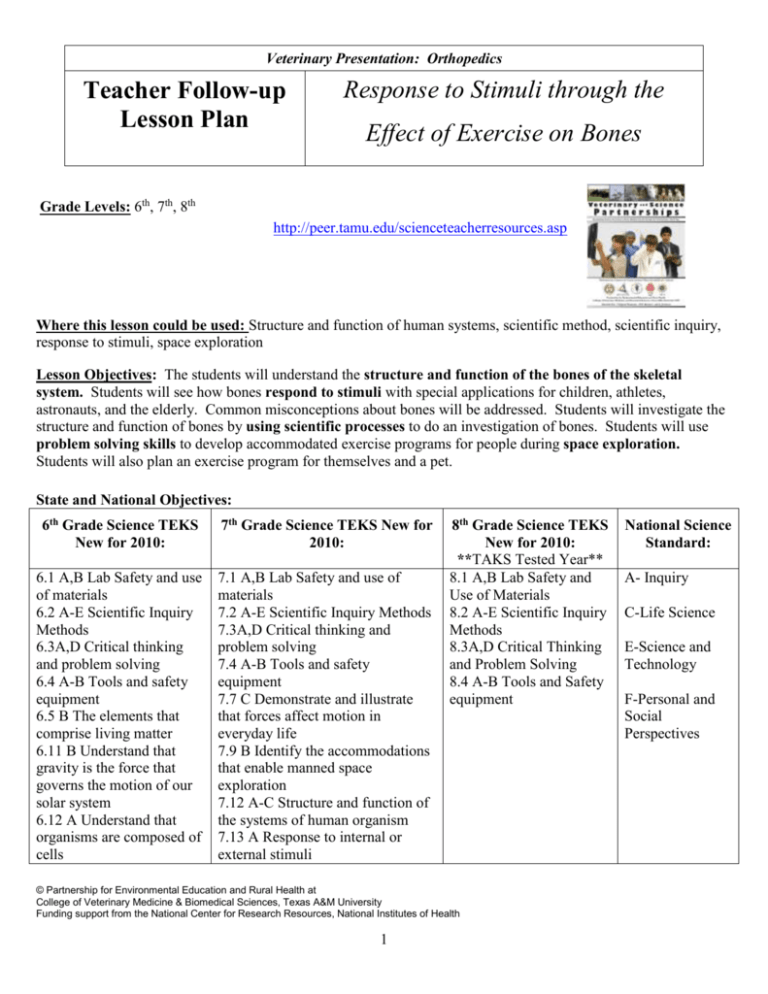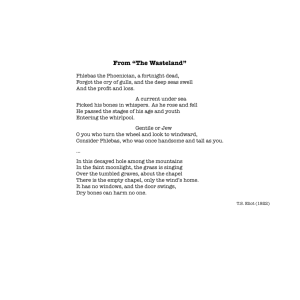Grade Level: 7th and 8th - PEER
advertisement

Veterinary Presentation: Orthopedics Teacher Follow-up Lesson Plan Response to Stimuli through the Effect of Exercise on Bones Grade Levels: 6th, 7th, 8th http://peer.tamu.edu/scienceteacherresources.asp Where this lesson could be used: Structure and function of human systems, scientific method, scientific inquiry, response to stimuli, space exploration Lesson Objectives: The students will understand the structure and function of the bones of the skeletal system. Students will see how bones respond to stimuli with special applications for children, athletes, astronauts, and the elderly. Common misconceptions about bones will be addressed. Students will investigate the structure and function of bones by using scientific processes to do an investigation of bones. Students will use problem solving skills to develop accommodated exercise programs for people during space exploration. Students will also plan an exercise program for themselves and a pet. State and National Objectives: 6th Grade Science TEKS New for 2010: 7th Grade Science TEKS New for 2010: 6.1 A,B Lab Safety and use of materials 6.2 A-E Scientific Inquiry Methods 6.3A,D Critical thinking and problem solving 6.4 A-B Tools and safety equipment 6.5 B The elements that comprise living matter 6.11 B Understand that gravity is the force that governs the motion of our solar system 6.12 A Understand that organisms are composed of cells 7.1 A,B Lab Safety and use of materials 7.2 A-E Scientific Inquiry Methods 7.3A,D Critical thinking and problem solving 7.4 A-B Tools and safety equipment 7.7 C Demonstrate and illustrate that forces affect motion in everyday life 7.9 B Identify the accommodations that enable manned space exploration 7.12 A-C Structure and function of the systems of human organism 7.13 A Response to internal or external stimuli 8th Grade Science TEKS New for 2010: **TAKS Tested Year** 8.1 A,B Lab Safety and Use of Materials 8.2 A-E Scientific Inquiry Methods 8.3A,D Critical Thinking and Problem Solving 8.4 A-B Tools and Safety equipment © Partnership for Environmental Education and Rural Health at College of Veterinary Medicine & Biomedical Sciences, Texas A&M University Funding support from the National Center for Research Resources, National Institutes of Health 1 National Science Standard: A- Inquiry C-Life Science E-Science and Technology F-Personal and Social Perspectives Orthopedics Response to Stimuli through the Effect of Exercise on Bones Background Information for Teachers: Bones are dynamic structures, responding to diet, age, and mechanical forces. Bones are constantly undergoing a process of breaking down and rebuilding. Wolf’s Law states that bones react to the stresses put on them. When people exercise, they are putting stress on their bones. The bones react by becoming stronger and better suited to more exercise. Animals’ bones also respond in the same manner. Special implications apply to children, athletes, astronauts, and the elderly. When astronauts travel in space, they lose their bone strength if they do not do specially accommodated exercises, because the lack of gravity in space causes less force to be exerted on their bones. Athletes put great stresses on their bones and that causes differences in strength in the bones. Children are growing and forming new bone. The elderly lose bone quickly if they do not take special precautions. It is important for people and their pets to get sufficient amounts of exercise so that their bones become strong and stay strong throughout their lives. Materials needed: Effect of Exercise on Bones PowerPoint Presentation Effect of Exercise on Bones Worksheet with Key Included Chicken Wing Activity Sheet Welcome to the Future Activity Sheet Exercise and Pets Activity Sheet Video of Dog in Water Treadmill Dissecting Trays Dissecting instruments Chicken Wings (purchased from meat section of a grocery store) Computers with internet access Engage Prerequisite to Lesson: Veterinary Presentation1 and Background Information Students will need to have instruction in laboratory safety, including sharp instrument safety, before doing the lab activity in this lesson. Evaluate Explore 5 E’s Lesson Plan Lesson Procedures: 5E Model2 Engage, Explore, Explain, Elaborate, Evaluate Elaborate Explain Engage Step: Veterinary Visit or Video Presentation (1 class period) o The veterinary visit or video presentation will excite and engage students to learn about required scientific topics. o This lesson is designed to capitalize on students’ natural interest in animals to help motivate them to learn the required science curriculum. o Questions are asked to involve students and help them relate this lesson to their own lives. Explore Step: Chicken Wing Dissection (1 class period) o This is a laboratory activity that explores the structure and function of the bones in a chicken wing and compares them to the structure and function of the bones in humans. o Detailed instructions are given and the students are asked to investigate the bones, describe them, and make inferences about their function. o Several questions are posed, asking students to evaluate and analyze some real-life situations. 1 2 Veterinarian Visit or Video is highly recommended, but not mandatory, to use this lesson See 5E Model link under “Resources for Teachers” at end of lesson plan © Partnership for Environmental Education and Rural Health at College of Veterinary Medicine & Biomedical Sciences, Texas A&M University Funding support from the National Center for Research Resources, National Institutes of Health 2 Orthopedics Response to Stimuli through the Effect of Exercise on Bones Explain Step: Effect of Exercise on Bones PowerPoint (1 class period) o This PowerPoint lesson explains the structure and nature of bones and how bones respond to the stimuli of exercise and force. o There are some places in this PowerPoint where students are asked to answer questions, share ideas, or look at pictures. This allows the presentation to be interactive. o This PowerPoint addresses some common misconceptions about bones are addressed. This includes students’ perceptions that bones are “dead” and that once bones are formed, they stay the same throughout life. o There is a worksheet included in this lesson that has questions over the PowerPoint presentation. It has an answer key included. o There are some notes to the teacher in the notes section in the PowerPoint in the Edit View. o This presentation shows the real-life implications of exercise and bone strength related to children, astronauts, athletes, and the elderly. o There is a video of a dog on a water treadmill that can be used during this presentation. There is a question posed in a slide in this presentation about the purpose of a water treadmill. Students could view this short 20 second video and make inferences as to why the treadmill is useful. The dog in the video is not putting much force on its back legs. It can be inferred that its back or back legs are injured. The water treadmill allows the dog to exercise without further injuring its back or back legs. o Special mention is made of the elements that make up bone. Elaborate Step: has two options; the teacher may choose the one most appropriate for his/her class o Option One: Exercise and Pets (1 class period) In this activity, students are asked to review a website that covers topics related to exercise and pets. Students review several exercises that include people and their pets. Students are then asked to design an exercise program for themselves and a pet. Extensions are provided to allow students to carry out the exercise program and evaluate its effectiveness. o Option Two: Welcome to the Future (1 class period) In this activity, students are instructed to develop an exercise plan that can be used in space that will keep people’s bones strong for when they return to Earth. Several websites giving more information about exercise in space are included in the “Resources for Teachers” below. Although the activity is presented as a hypothetical one, NASA is conducting research on this topic; see “Resources for Teachers” below for information. Emphasis is placed on modifying exercises on Earth and accommodating them for use in space. This activity includes higher-level thinking skills like analyzing and designing. Extensions to this activity include having the students illustrate their plan and evaluate their own exercise program. Evaluate Step: o The activities in this lesson can be traditionally graded using a point scale. © Partnership for Environmental Education and Rural Health at College of Veterinary Medicine & Biomedical Sciences, Texas A&M University Funding support from the National Center for Research Resources, National Institutes of Health 3 Orthopedics Response to Stimuli through the Effect of Exercise on Bones Resources for Teachers: 5E model site and other lesson plan formats o http://www.personal.psu.edu/scs15/idweb/lessonplanning.htm PetFit Website o http://www.petfit.com/Petfit/PetfitLevel2.jsp?PetfitFolderName=FitnessHome NASA Research on Exercise in Space o http://www.nasa.gov/mission_pages/station/science/experiments/MARES.html o http://hacd.jsc.nasa.gov/projects/ecp.cfm o http://www.cnn.com/2008/HEALTH/09/16/nasa.bone.loss/index.html More Information about Exercise in Space o http://weboflife.nasa.gov/currentResearch/currentResearchGeneralArchives/workout.htm o http://www.nasa.gov/audience/formedia/presskits/fit_for_space.html © Partnership for Environmental Education and Rural Health at College of Veterinary Medicine & Biomedical Sciences, Texas A&M University Funding support from the National Center for Research Resources, National Institutes of Health 4






